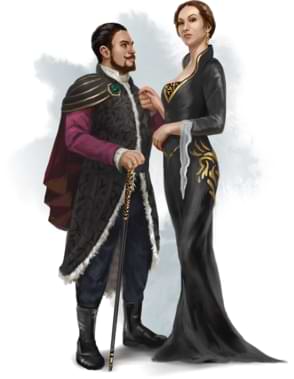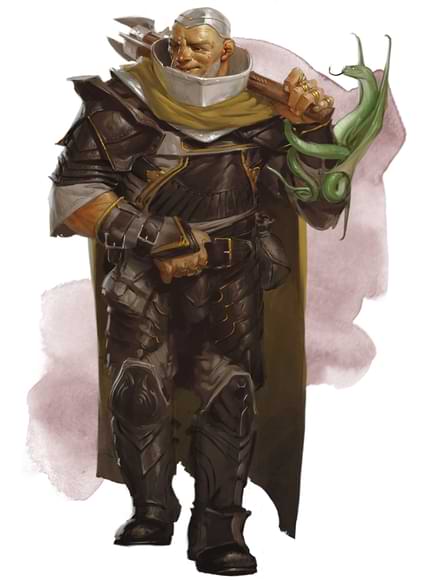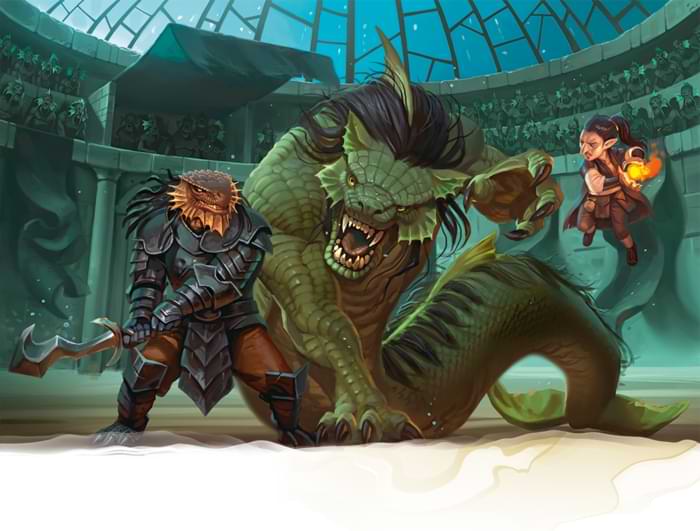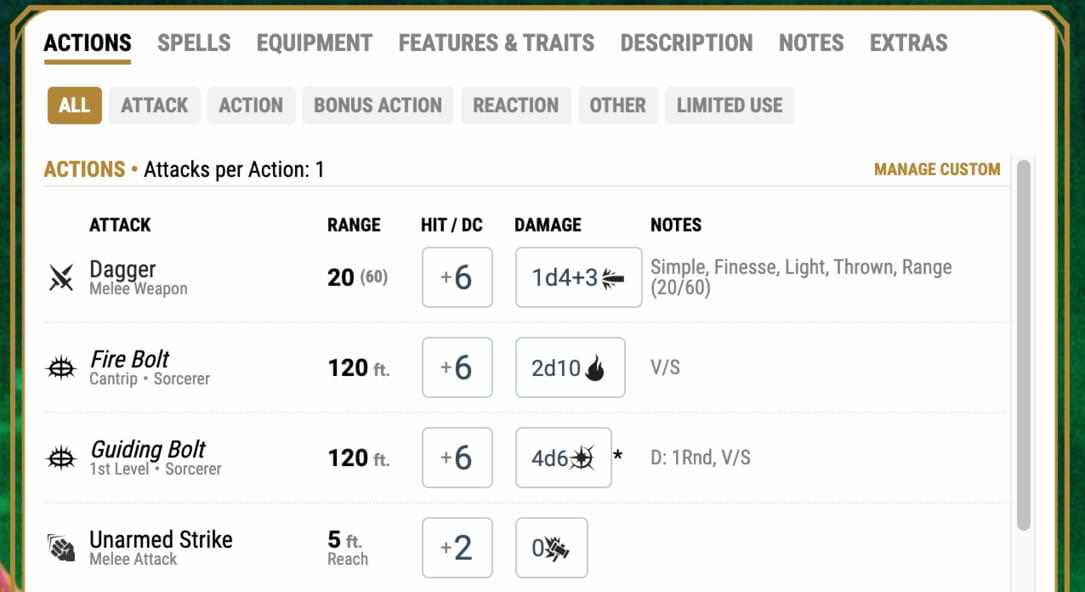Pit fighting is one of my favorite things to do during a campaign, whether your party enters a fighting contest for a session or you spend some downtime pit fighting using the rules presented in Xanathar’s Guide to Everything. If you're interested in adding flair to these kinds of fights, here’s how you can get started.
Running downtime? Try playing out pit fighting!
This downtime activity is typically resolved with a few rolls of the dice. But you might instead decide to play out one or more combats to determine your player character's success over a workweek of pit fighting. Doing so allows your players to bask in their characters' victories and roleplay their bitter defeats. This can also open up opportunities for your player characters to meet and interact with NPCs who might play a role in your adventure.
Be mindful of players whose characters are not participating in combat, however. Combat can take a while.Their characters should be given opportunities to play a role from the sidelines. Alternatively, you can set special rules for victory. For example, the first combatant to hit one-half their maximum hit points loses.
Choose your backdrop for combat
Not all fighting pits are seedy or underground — though we offer guidance on these below. You might opt for gladiator fights held in a coliseum where city folk can watch and place bets on their favorite combatants. Or, perhaps, a local lord requests a player character fight in the private gardens of their estate during a party held for members of the upper class. Take a look at these sample settings for your fights.
Brawl in the lord’s garden
You enter the lush gardens of a local lord’s villa. Colorful and exotic flowers dot this area as tall hedges dampen the sounds of a nearby bustling city street. Near a long table overflowing with baked goods, fruit, meat, and fish stand nobles and aristocrats who mingle and sip on fine wine from golden goblets. Some notice your entrance, and an excitement fills their eyes. The stage — your arena for tonight — is an elevated platform of white marble near which rows of fine seats have been set up around.
 Fights held by upper-class people are extravagant affairs. Player characters might be offered fine food and drink before their bouts, and noble people could be thrilled to hear tales from adventurers who earn coin through more exciting (and deadlier) work.
Fights held by upper-class people are extravagant affairs. Player characters might be offered fine food and drink before their bouts, and noble people could be thrilled to hear tales from adventurers who earn coin through more exciting (and deadlier) work.
Depending on the legality of the event and social customs, cheers might be hushed with clapping kept to a low volume. Or the event could be held in the crowded entrance hall of a mansion, where cheers are deafening and the local guard is paid off to turn a blind eye to the bout.
This type of fighting pit can include NPCs such as politicians, nobles, and other well-to-do folk. Participation can earn winning player characters information important to your adventure’s story, or create conflict with NPCs who bet on the opposition.
Battle in the coliseum for the masses
The dusty iron gate clangs as it opens before you. The hot, bright sun bears down on the coliseum’s arena, where the air is abuzz as spectators anxiously await the fight. The seats of the coliseum stretch upward row after row, and the empress’s seat is cloaked in shadow. Your heart thumps loudly in your chest as the opposing gate slowly opens to reveal your opponent.
A coliseum match is a show-stopping event that an entire city will want to show up for. What makes these matches exciting is the fact that player characters won’t know who or what will enter the arena from the opposing gate. Backroom deals could buy the player characters an advantage in combat — or lead to a harder encounter thanks to a rival who would prefer them dead.
For NPCs, lower- and middle-class attendees can commonly be found in the stands. A good show can earn player characters fame in the city. People might even stop them in the streets for an autograph. Local or foreign leaders can also make an appearance and help player characters snag some high-profile work, depending on how they perform.
Cage fight in a seedy tavern
You walk into a rowdy and dimly lit tavern. Heads turn and voices hush as you walk past the bar and tables. A narrow hallway leads down a flight of stairs to a basement that smells of sweat and ale. A 10-foot tall cage encloses a pair of combatants and is surrounded by tavern patrons. Both combatants are bloodied and weary but continue delivering devastating blows to cheers.
 Tavern fights can be easily accessed and used to settle a score with an NPC or to make your player characters some easy coin. Fights are likely to be interrupted by the local guard but can also help make a reputation for your player characters among seedier folk. Tournaments can be a great way to keep your player characters returning for more bouts, as they can battle for a title — or be asked to defend one.
Tavern fights can be easily accessed and used to settle a score with an NPC or to make your player characters some easy coin. Fights are likely to be interrupted by the local guard but can also help make a reputation for your player characters among seedier folk. Tournaments can be a great way to keep your player characters returning for more bouts, as they can battle for a title — or be asked to defend one.
Taverns present an opportunity to include all manner of colorful NPCs, including the village drunkard, adventurers who are passing by, and members of disreputable organizations, such as the Zhentarim. The tavern barkeep could become a quick fan of your player characters and offer free drinks if their name carries weight in the area.
Fight to the death in underground rings
You knock on the backdoor of the local butcher’s shop after working hours. Upon uttering a secret password, the butcher opens the door and allows you in. They lead you through the back of the shop, past cuts of meat hanging from hooks. You descend down a steep set of stairs and find yourself in the sewers below the city, where you soon find a stone-floored arena surrounded by a spiked pit.
Often held in clandestine locations, these matches require player characters to first talk to certain NPCs in order to gain entry. A good fighting record in a seedy tavern could also land player characters a mysterious invitation to fight for organizations like the Xanathar Guild. Unlike your typical tavern brawl, these matches could be a fight to the death and offer bigger prizes, including renown (detailed in the Dungeon Master’s Guide).
Fighting in these arenas might be the only way to catch the eye of a crime lord who could grant access to certain hideouts or offer information on illegal activities. Spies of opposing factions might also be present, as well as common criminals evading the local guard.

Decide on the type of match you’ll run
Now that you’ve established the backdrop for your fights, it’s time to fill the ring with combatants. Consider the following types of matches you can run at your table:
One on one matches are a good go-to option. These are bouts where one player character goes up against an NPC or a party member in a one-time match or as part of your downtime spent pit fighting. Don’t be shy about throwing surprises at your players, though. Imagine the shock — and glee — at your table when a deinonychus enters the ring.
In the campaign I'm playing in, two player characters have frequently butted heads — so much so that they almost started fighting each other while the rest of the party was trying to fend off a spirit naga. They decided to hash things out in an unarmed bout. The fight took place on our pirate ship and other players were able to place bets. (I may or may not have instigated the betting.) Both PCs agreed that once the fight was over, it would be the end of their feud.
In this case, one-on-one matches can serve as a way to settle conflicts. Is there an NPC in your game that a player character just can't stand? Have the NPC challenge them to a fight.
Party versus group is where the entire adventuring party takes on another mercenary group or groups. These opposing groups can include NPCs they’ve met in the past or serve as a way to foreshadow a future encounter. You can take this a step further by pitting the adventuring party against groups of creatures that work well in multiples, such as kobolds, which have Pack Tactics.
Consider pairing up different types of creatures to spice things up. An ogre with a pet giant vulture can make for a memorable encounter. In this type of fight, aim to have a mix of ranged and melee combatants to keep your party on their toes.
 Group versus boss can offer a gladiator-style feel to your session. Raise the ante by keeping your players in the dark about what type of creature is behind the gate until it’s unleashed upon them. A hydra always makes for an exciting encounter when appropriate for the party's level.
Group versus boss can offer a gladiator-style feel to your session. Raise the ante by keeping your players in the dark about what type of creature is behind the gate until it’s unleashed upon them. A hydra always makes for an exciting encounter when appropriate for the party's level.
Take into consideration the encounter difficulty for these fights. Encounters is a great tool for planning combat appropriate for your party. If you intend on your bouts to be nonlethal, you can narrate to the group how a particular monster has been trained to cease fighting when given a particular cue.
Group versus boss combat gives your players an opportunity to fight creatures that might not otherwise suit your campaign. And if you encourage your players to score style points, such encounters can make for memorable moments in the adventure. For example, take a look at the rules for climbing onto a bigger creature presented in the Dungeon Master's Guide.
Free-for-all matches can bring about some chaotic fun. By pitting the party against other NPCs or one another, you create moments where two characters are fighting each other until they need to team up in order to take down a bigger threat before facing off again. In these bouts, the last one standing wins.
Lay down some ground rules
You will need to determine if these matches will be armed or unarmed, and if magic is allowed. If you permit weapons but want to maintain a level playing field, you can require your player characters to turn in their magical weapons for the bout. Similarly, fighting pit organizers might disallow the casting of spells of a certain level and higher.
Of course, you can opt for the tried-and-true weapon of fighting pits: unarmed strikes.
How to calculate damage from unarmed strikes
An unarmed strike deals bludgeoning damage equal to 1 + your Strength modifier. The monk’s Martial Arts class feature can modify how unarmed strikes work:
- You can use Dexterity instead of Strength for the attack and damage rolls of your unarmed strikes and monk weapons.
- You can roll a d4 in place of the normal damage of your unarmed strike or monk weapon. This die changes as you gain monk levels, as shown in the Martial Arts column of the Monk table.
To roll for an unarmed strike using D&D Beyond, navigate to your character sheet and find the unarmed strike Attack action under the Actions tab.

This poor combatant won’t be doing much damage in fisticuffs with his 8 Strength!
Complications in the fight
Complications can add to the excitement of pit fighting, and force your players to think on their feet. Your players might think victory is near when, suddenly, a fog spreads across the arena, obscuring their vision and potentially making them unaware that a new combatant has joined the fight.
Consider these other examples of complications:
 Your opponent is a cheat! The opposing combatant is friends with a spellcaster who is hidden among onlookers and who is casting spells on you. (Is that you, Snape?) Now the party members who are watching the fight need to sniff out the spellcaster to put an end to their antics.
Your opponent is a cheat! The opposing combatant is friends with a spellcaster who is hidden among onlookers and who is casting spells on you. (Is that you, Snape?) Now the party members who are watching the fight need to sniff out the spellcaster to put an end to their antics.- The monster is out of control! The party is on the verge of victory. Suddenly, a loud crash comes from beyond the gates. A manticore has broken out of its cage and found its way into the arena. Its eyes are red with rage as it rushes toward the combatants.
- The fighting ring has been outfitted with traps! Your player characters enter the arena and — just as the match begins — they hear a grinding noise and watch as a large blade swings across the ring, threatening to lop off their heads. Now they’re forced to deal with their opponent and a deadly trap. Will the player characters try to disable the trap or simply fight around it?
- Someone called the guard! The player characters are in the middle of a brawl held at an underground fighting pit. Suddenly, a group of guards burst in and start making arrests. Now the player characters are faced with a decision: fight the guards or make an escape.
If you are running downtime, we also recommend checking out the complications offered for the pit fighting activity:
Pit Fighting Complications
Characters involved in pit fighting must deal with their opponents, the people who bet on matches, and the matches’ promoters. Every workweek spent pit fighting brings a 10 percent chance of a complication, examples of which are on the Pit Fighting Complications table.
| d6 | Complication |
| 1 | An opponent swears to take revenge on you.* |
| 2 | A crime boss approaches you and offers to pay you to intentionally lose a few matches.* |
| 3 | You defeat a popular local champion, drawing the crowd’s ire. |
| 4 | You defeat a noble’s servant, drawing the wrath of the noble’s house.* |
| 5 | You are accused of cheating. Whether the allegation is true or not, your reputation is tarnished.* |
| 6 | You accidentally deliver a near-fatal wound to a foe. |
* Might involve a rival
Source: Xanathar's Guide to Everything
Rewarding your players
One of the best parts about entering a fighting pit is the gold player characters can earn if victorious. Those who opted out of a fight can even make bets on the winner to try and make some gold.
Xanathar's Guide To Everything details rewards for a workweek’s worth of gambling and pit fighting. This can be a good starting point when determining what kind of gold you might reward your player characters, whether you are running downtime or just want to play out a session in the ring. See what makes sense for your game. You might decide, for example, that combatants must ante up items of similar value, with the winner claiming all the anted items.
Of course, victory alone can be worth the battle. One of the greatest rewards in pit fighting can be the friends you beat up along the way. Happy brawling!
Van Richten's Guide to Ravenloft is available for preorder now in the D&D Beyond Marketplace! All preorders come with digital dice, as well as character themes, frames, and backdrops! Subscribers are able to share all of their purchased content with their table!
Wendy (@WendyLeeSzany) is a host, actor, and content creator based in Los Angeles. When she’s not spending her time making too many new characters on D&D Beyond, she’s rolling dice as Glita on Bedlam And Discord on Twitch. You can find Wendy talking pop culture and movie news on The Movie Couple YouTube channel and geek fashion on Geek & Glitter.








-
View User Profile
-
Send Message
Posted Apr 30, 2021Cool
-
View User Profile
-
Send Message
Posted Apr 30, 2021great article!
I have actually done quite a bit of arena fighting. I agree that it can be a ton of fun when done properly, and can even be used to set the stage for a large plot.
-
View User Profile
-
Send Message
Posted Apr 30, 2021Pretty interesting, even with just a brawl aka fist fighting.
-
View User Profile
-
Send Message
Posted Apr 30, 2021Thank goodness the article wasn’t full of adds!
You might even be part of a gruesome pit fight hosted by one of the Lords of Ravenloft, as detailed in Van Richten’s Guide to Everything, which you can pre-order now!
Of course, complications in a pit fight could arise from mysterious circumstances. For inspiration, try browsing through Candlekeep Mysteries!
-
View User Profile
-
Send Message
Posted Apr 30, 2021I know, right?
-
View User Profile
-
Send Message
Posted Apr 30, 2021I. LOVE. IT! This is such a fun article in so many ways! I love the cutscene descriptions, the different kinds of pit fight, the mid-fight complications. This is so much fun! As a player, I can't hope but wish my DM uses this. Time to make a streetfighter and find the fight clubs! As a DM, I'm totally going to introduce this during some downtime or use the coliseum cutscene. Maybe I'll homebrew some sort of creature that executes gladiators. I was thinking The Guillotine Golem, the mad creation of an evil dictator who uses it to destroy his foes under the pretense of a gladiatorial challenge for the fun of the people, who have to come see their heroes slaughtered. This is gonna be a lot of fun... >:). Also, maybe some innocent, legal, nonlethal pit fights. Whatever.
-
View User Profile
-
Send Message
Posted Apr 30, 2021XD! Yes! Thanks for doing the marketing crew's job for them. If all readers were as loyal as you, we would no longer have anti-ad comments.
-
View User Profile
-
Send Message
Posted Apr 30, 2021I’m playing this in Waterdeep. I dare you to convince me otherwise
-
View User Profile
-
Send Message
Posted Apr 30, 2021This is a great article! Thank you for structuring it in such an viewer-friendly manner.
-
View User Profile
-
Send Message
Posted Apr 30, 2021While running Waterdeep: Dragon Heist, I added a fighting pit locale to the map where my PCs could visit if they ever just wanted to get into some combat. They had a lot of fun with it. A couple of players even became local celebrities.
-
View User Profile
-
Send Message
Posted Apr 30, 2021Yeah. Also, great article!
-
View User Profile
-
Send Message
Posted Apr 30, 2021Now I want my Sea Elf Barbarian to start another bar fight.
-
View User Profile
-
Send Message
Posted Apr 30, 2021This seems like a really fun downtime activity. It could definitely lead into a bigger plot and now I'm inspired to do just that.
I don't think I've seen any articles by you before. I could be wrong, but if not, this is a great first article!
-
View User Profile
-
Send Message
Posted May 1, 2021Thanks, I will take all info about how to play and this helped.
-
View User Profile
-
Send Message
Posted May 1, 2021I came online to touch up my campaign that starts with pit fighting. thank you weird coincidence
-
View User Profile
-
Send Message
Posted May 1, 2021Thieving this for my campaign.
-
View User Profile
-
Send Message
Posted May 1, 2021Yeah if it helps, they are all chosen as the cities sacrifices to keep the whole city safe from a devil who made a pact with the king. 5 sacrifices a month and the devil would keep everybody in the city happy with great lives. thing is, the arenas creatures get defeated and the players are still alive by the time the devil requires his sacrifices. So in spite he kills every patron in the arena before smiting the players and sending them to Avernus. The adventure continues in Avernus but session 1 will hopefully end with them all dead and me just saying "So see you all here next week?"
-
View User Profile
-
Send Message
Posted May 1, 2021This was really helpful
-
View User Profile
-
Send Message
Posted May 1, 2021I incorporated an underground fight club in my campaign and did a first-round test with my PCs; went okay, though I was transparent that this might get better (and so change) in time. The idea of being patronized and fighting in professional gladiator matches - against beasts and such - sounds like a really great mini-arc.
-
View User Profile
-
Send Message
Posted May 1, 2021Finally some complications and easy-to-include examples! Good article!